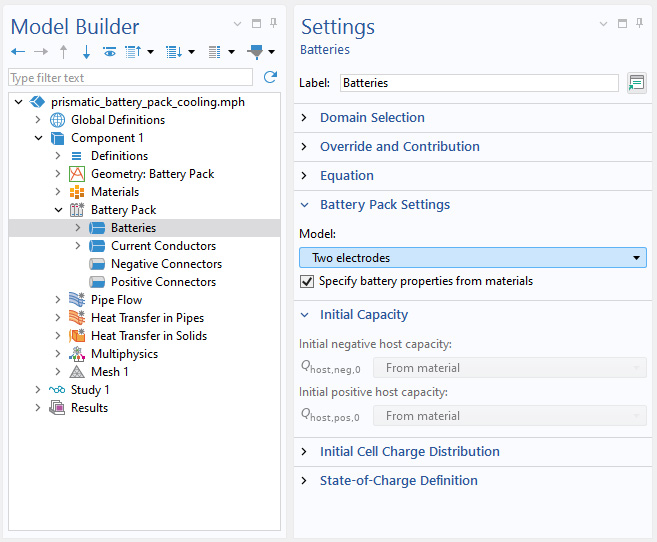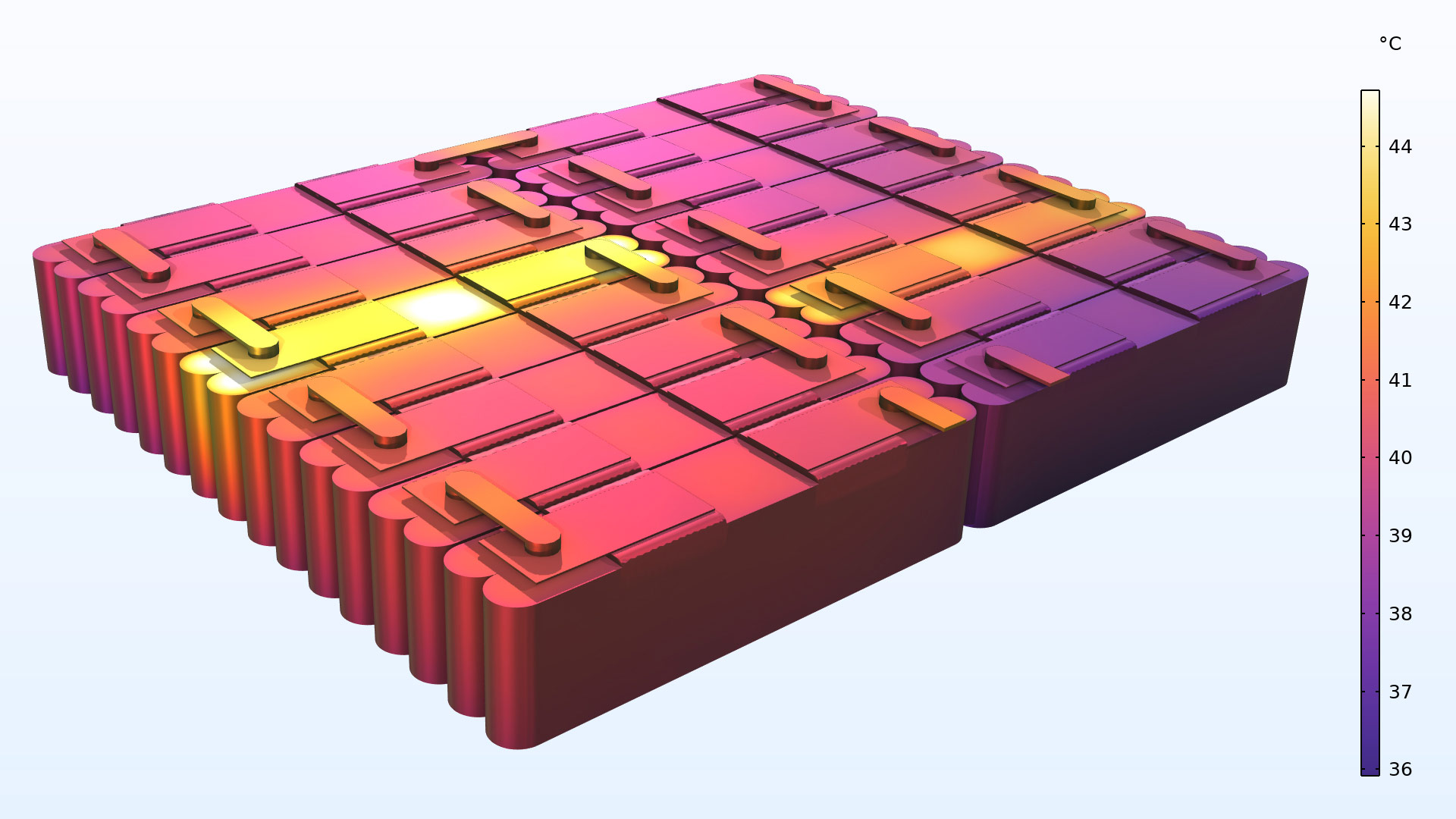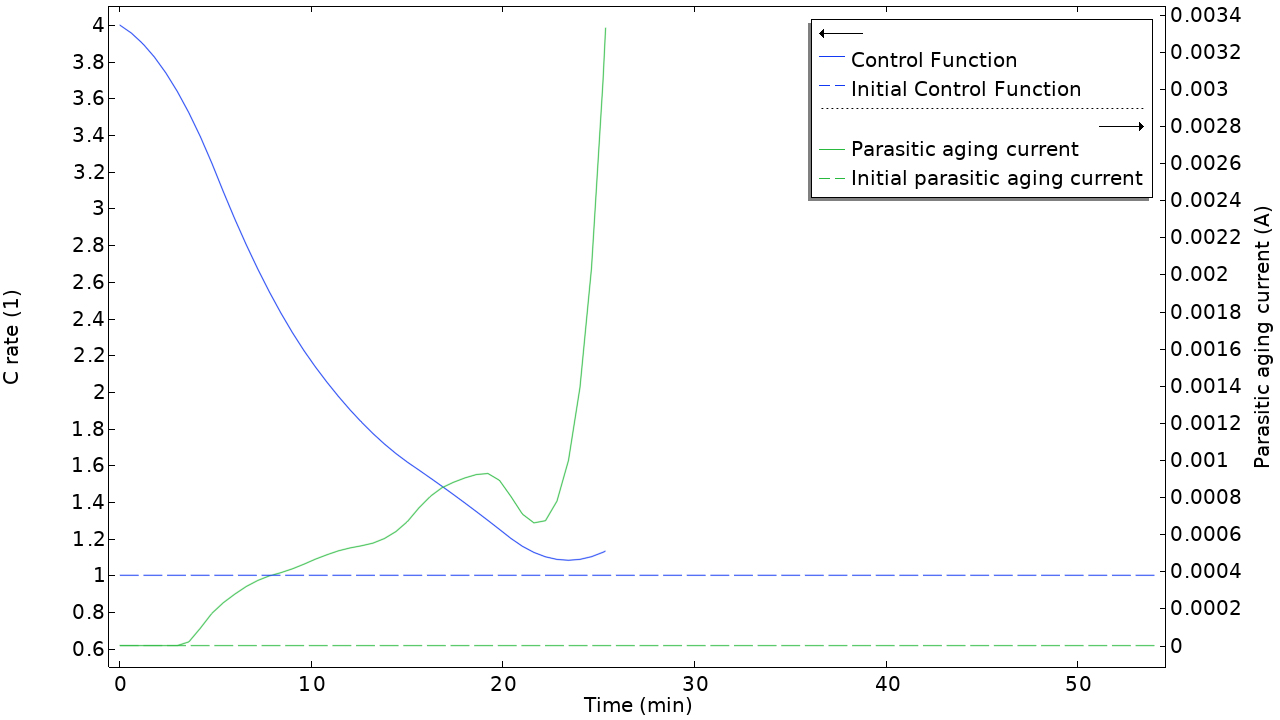Battery Design Module Updates
For users of the Battery Design Module, COMSOL Multiphysics® version 6.4 introduces new power loss variables, the ability to define arbitrary charge–discharge load cycles, and significantly more user-friendly and accurate modeling of heat transfer in prismatic batteries. Read more about these updates and more below.
Power Loss Evaluation Variables
It is now possible to evaluate the magnitude of total power losses in a battery cell and compare losses among individual components, such as the separator, electrode, and current conductor, using newly introduced power loss variables in the Electrochemistry interfaces. These variables can also be used to compute the round-trip energy efficiency of a battery cell under a charge–discharge load cycle by integrating power losses over time.
The power losses are defined based on the losses in the Gibbs free energy of all reacting and transported species, enabling differentiation between ohmic, concentration, and activation losses. In battery interfaces that support particle intercalation, separate intercalation transport loss variables are also defined. These variables are available locally on domains and boundaries, as integrated values over the entire cell, or per individual model tree feature node. The overpotential contributions of each loss mechanism (ohmic, activation, and transport) can be computed by dividing by the total current.
This functionality can be viewed in the new Power Losses in a Lithium-Ion Battery tutorial model.

Load Cycle
To enable simpler setup of complex cycling schemes, a new Load Cycle feature has been added to most of the Electrochemistry interfaces. This feature can be used to define arbitrary charge–discharge load cycles, where Voltage, Power, Current, C-rate, and Rest steps may be added in any sequence. For each step in the load cycle, one or multiple dynamic continuation or break (switching) criteria can be defined, which may be based on time, voltage, or current limits as well as user-defined conditions using arbitrary variable expressions. In addition to the versatile load cycle definition options, the new feature also allows for automatic definitions of current and voltage probes as well as solver stop conditions.
With the Subloop subfeature, it is possible, for instance, to intermix long-term charge–discharge cycling tests with reference performance tests. Note that the Power and Subloop subfeatures are only available in the Battery Design Module and the Fuel Cell & Electrolyzer Module.
The following tutorial models have been updated to demonstrate this feature:
- li_battery_1d
- lib_base_model_1d
- lib_diffusion_induced_stress
- li_rate_capability
- lib_drive_cycle
- lib_single_particle
- li_battery_multiple_materials_1d
- li_plating_with_deformation
- zn_ago_battery_1d
- lithium_sulfur
- li_battery_thermal_2d_axi
- li_battery_thermal_3d
- li_battery_pack_3d
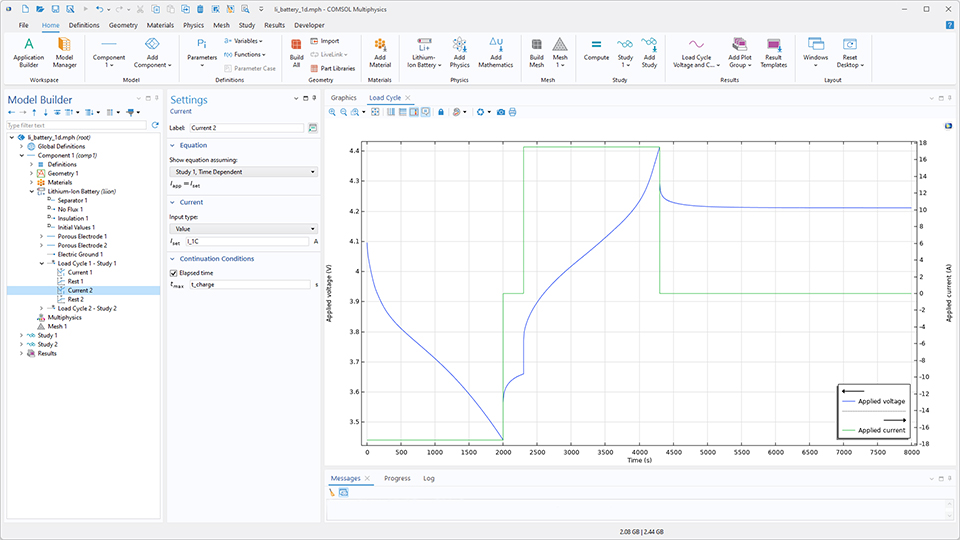
Heat Transfer in Prismatic Batteries
To facilitate accurate modeling of heat transfer in prismatic batteries, a new Flat-sided oval (prismatic) layer configuration option has been added to the Battery Layers node in the Heat Transfer interfaces.
With the Semicylinder Selection and Rectangular Block Selection subfeatures, the Battery Layers feature can now automatically define the combined cylindrical and Cartesian coordinate systems required to correctly specify anisotropic thermal conductivity tensors in prismatic battery jelly rolls. This provides an accurate description of the thermal conductivity in the jelly roll, accounting for the different battery component layers and their winding. View this new functionality in the Liquid-Cooled Prismatic Battery Pack and Cooling of a Prismatic Battery tutorial models.
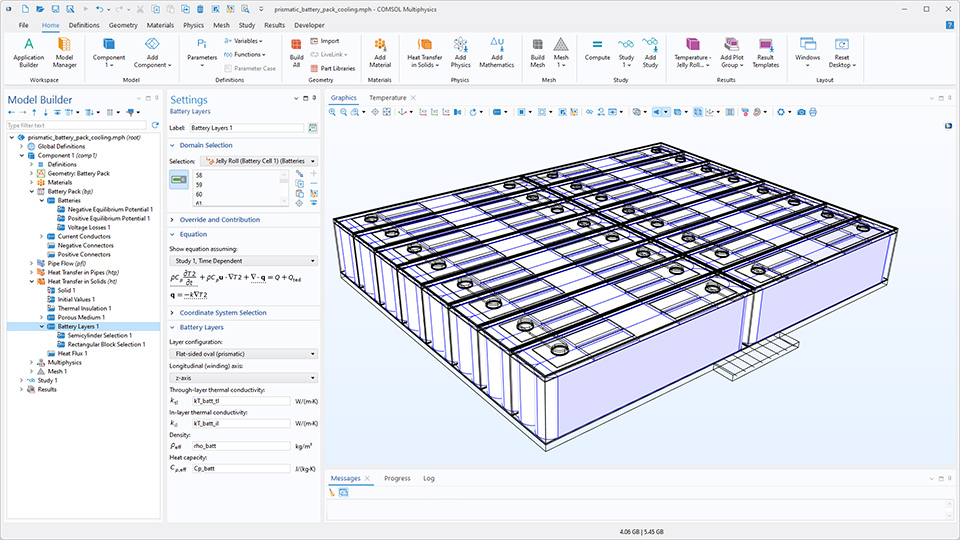
Battery Pack Two Electrodes Model Option
To model individual electrode behavior in each battery cell of a battery pack, the Two electrodes model option, previously available in the Lumped Battery interface, is now also available in the Battery Pack interface.
This model option can be used to define the electrode potential, initial host capacity, and degree of conversion separately for the two electrodes in each cell. It can also be used to define individual electrode properties to account for ohmic, activation, and concentration overpotentials. When concentration overpotentials are included, the Two electrodes model corresponds to what is commonly referred to in the literature as the single-particle model (SPM). View this functionality in the new Liquid-Cooled Prismatic Battery Pack tutorial model.
Aqueous Electrolyte Transport
For modeling aqueous electrolytes featuring weak acids, weak bases, ampholytes, and generic complex species — and for applications such as mechanistic corrosion modeling, electrochemical models of biological systems, and electrochemical sensor modeling — a new Aqueous Electrolyte Transport interface computes the potential and species concentration fields in a dilute aqueous electrolyte. The transport is defined by the Nernst–Planck equations, incorporating diffusion, migration, and convection, together with electroneutrality and the self-ionization equilibrium reaction of water (autoprotolysis). Due to its more efficient handling of equation reactions and easier model setup, the new interface may be more preferable to use in some cases than the more generic Tertiary Current Distribution, Nernst–Planck interface.
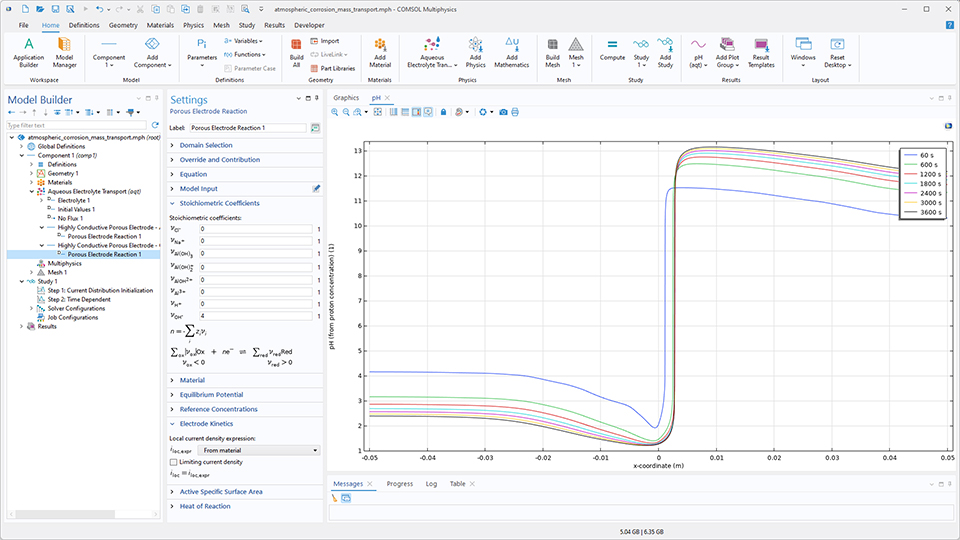
Automatic Initialization of Ion-Exchange Membrane Models
To ensure electroneutrality and compliance with Donnan equilibria, the Ion-Exchange Membrane feature in the Tertiary Current Distribution, Nernst–Planck interface now includes an Add Donnan shift to initial values option. This option automatically shifts the initial concentration and potential values specified in the Initial Values feature for the active Ion-Exchange Membrane domain node, assuming that the user-defined values represent the values for a bulk liquid electrolyte in equilibrium with the membrane. The shifted initial values are then used as initial values for the solver. Enabling this option typically simplifies model setup by eliminating the need to sweep the membrane’s fixed space charge to a desired nonzero value through an additional study step. View this functionality in the Vanadium Redox Flow Battery tutorial model.

Periodic Condition
A new Periodic Condition feature has been added to the Darcy's Law and Richards' Equation interfaces to easily enforce periodicity for the flow between two or more boundaries. In addition, it is possible to create a pressure difference between source and destination boundaries, either by specifying the pressure jump directly or by prescribing a mass flow. The periodic condition is typically used to model representative volume elements and compute effective properties for use in homogenized porous media.

Pressure Jump Option for the Free and Porous Media Flow Coupling
The Free and Porous Media Flow Coupling has a new option to include a pressure jump across the free–porous boundary. This makes it possible to model, as examples, the osmotic pressure at a semipermeable membrane supported by a porous spacer material or a pressure jump due to capillary pressure in the case of multiphase flow.
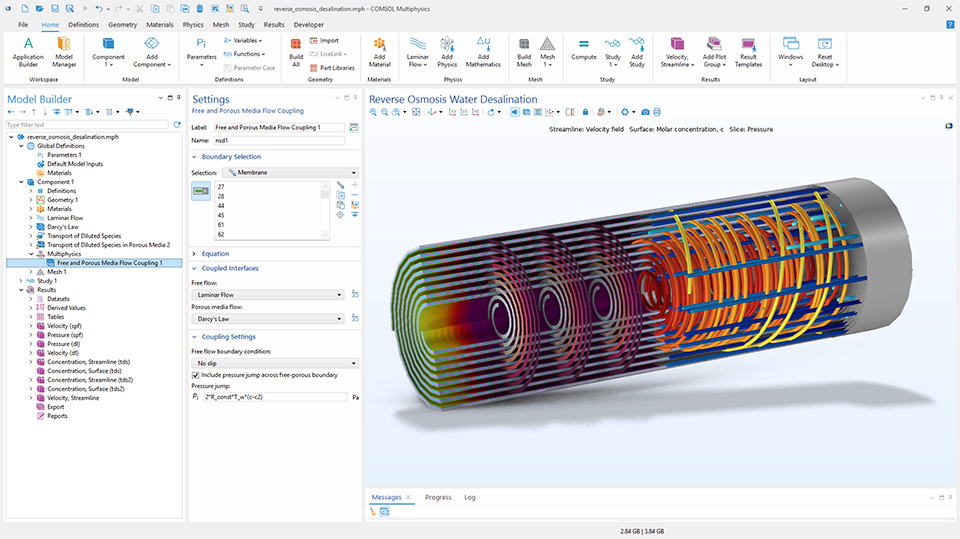
New and Updated Tutorial Models
COMSOL Multiphysics® version 6.4 brings several new and updated tutorial models to the Battery Design Module.

